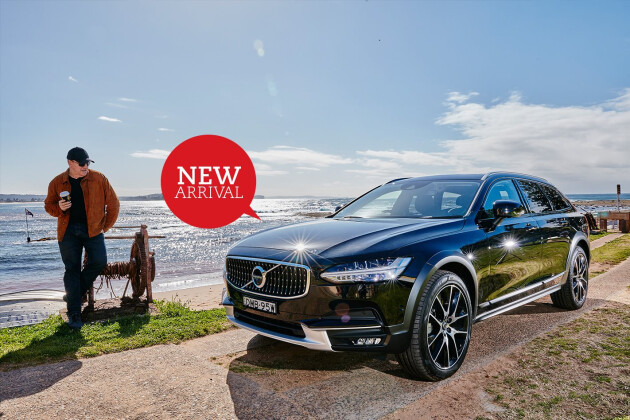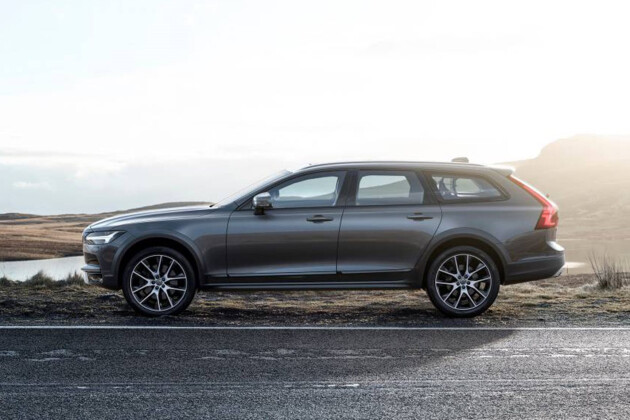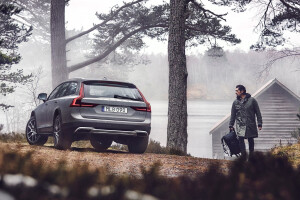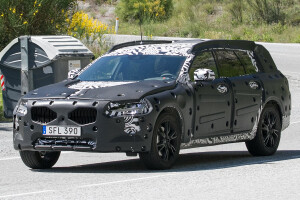Latest Review

2017 Volvo V90 Cross Country long term review
In a world where the SUV rules, is a high-riding, body-clad wagon relevant anymore? The Volvo V90 Cross Country is here to make a stand
Back in around 2002, I used to cycle past a Volvo dealership not far from where I lived on Sydney’s lower north shore.
I swear if the wind was blowing right, you could hear the morose howls from the dealer principal as he surveyed his ghost-town forecourt, and you could just about watch the cobwebs growing around the mirrors of the undesired C70s and S80s.
Amazing how a change of ownership can reinvigorate a brand. Chinese giant Geely bought Volvo from Ford in late 2009, and immediately set about giving the Swedes access to Chinese finance, paid for a new Chinese manufacturing base and generally gave them the resources they needed to revitalise the line-up and produce relevant, competitive cars.
Global sales last year were 534,127, almost exactly 200,000 units more than Volvo shifted in 2009. And while the all-new Volvo XC60, due here soon, is primed to be the brand’s volume model, the wagon lover in me was keen to try the V90, the car Ben Oliver drove to Sweden’s most remote restaurant.
“No can do,” said Volvo Australia. It turns out a decision as to whether the regular V90 will join the local range is yet to be made.
Instead, I was offered this; the high-riding Cross Country version of the V90, jacked-up by 60mm, armed with underbody and sill protection, and sold here only with the
2.0-litre twin-turbocharged four-cylinder diesel making 173kW and 480Nm, rather than the 2.0-litre petrol that’s turbo- and supercharged (for 235kW/400Nm) that
can be fitted to the S90/V90, as well as the XC90 and forthcoming XC60.
So, I’m now the proud custodian of a large all-wheel-drive wagon, built to handle light-duty off-road driving, and priced at $99,900. It’s worth noting that figure is about 10 percent sharper than its rivals like Audi’s A6 Allroad ($112,855) and the new Mercedes-Benz E-Class All-Terrain at $109,900.
The options list for my car has been given a nudge, but not to an abnormal degree for this class. Mine is fitted with the $3000 Technology Pack, which adds head-up display, 360-degree camera, digital radio tuner, and Apple CarPlay/Android Auto smartphone integration.
Then there’s the Lifestyle Pack at $2000, which includes perforated charcoal-coloured Nappa leather, heated front seats, a vast sunroof, and tinted rear glass. Added to this is front-seat ventilation for $1200, power cushion extensions for the front seats at $650, and 20-inch Tech Grey machine-finished wheels with Pirelli P Zero rubber for $2850. Finally, there’s the black metallic paint at $1900.
That brings the total to $111,500 plus on-roads, but does leave a significant option bundle called the Premium Pack unchecked. There is no drive-mode selector, for example. You get in, you drive; one mode fits all. But I suspect I’ll miss drive modes less than a couple of other bits of equipment. The standard sound system is reasonable but not a patch on the 1400-watt Bowers & Wilkins system also included in the Premium Pack.
Perhaps the most noteworthy exclusion, though, is the rear air suspension which is also part of this elusive bundle. Without it, the V90 runs a transverse, composite leaf-spring rear suspension system. First impressions, with the car on those plus-one 20-inch wheels, is the ride does not deliver the suppleness, refinement or comfort one could reasonably expect in this class.
The wheels and Pirellis do look great, but they sit as a slight spec anomaly on a Cross Country model, seeming about as well-suited to mud ’n’ guts adventures as Graham Norton in a pair of Tom Ford brogues.
There’s no questioning the strength of the engine for a four-pot, however, while the cool, minimalist Scando interior design has won me over, and has me reaching for my black turtle-neck sweater and wire-rim glasses. And did I mention the size? I can hear my own voice echo, it’s so cavernous inside. Actually, maybe I should just stop singing along to Roxette.
Untimely advice
The head-up display is great in that it shows speed zones; the only problem is its software is sometimes wrong. Anything that is a 40km/h zone during school hours is always a 40km/h school zone; the Volvo is convinced there are kids wandering the road at 10pm on a Sunday night. Meanwhile, on the Bradfield Expressway after crossing the Harbour Bridge, the car advises the 80km/h zone is actually 30km/h; guidance that would see you rear-ended if you took it.
Unscheduled stoppage
I’m wondering if Volvo sources its AEB sensor equipment from the same supplier as Mercedes-Benz, because my car exhibits the same false-alarm and braking intervention as that which has affected Ryan’s E-Class. Sometimes you know why the system has triggered; it may be a pedestrian island up the
road that the car thinks you’re on course to hit. But there have been other times where I’m at a loss to explain what the car has sensed to spook it. How do I convince the Volvo to relax?
UPDATE 1
IF YOU were asked to name the ultimate hero-to-villain downfall of the modern age, I wonder if your first reaction would be, “Grant Hackett in an economy-class seat”?
But I’d suggest the slippery slope that diesel fuel has found itself on in recent years is of greater global significance, unless of course you were the owner of that cruelly tweaked nipple on a Virgin Australia flight over Melbourne back in April last year.
Diesel fuel was, for decades, touted as Europe’s supposed energy saviour, subsidised because of its energy-dense ability to reduce consumption and therefore CO2. Since then we’ve had dieselgate, alarming warnings as to how NOx emissions can be worse for your health than binge-watching a season of Real Housewives of Melbourne, and recently, Volvo’s announcement that its current diesel tech will see it out, as the company transitions to a purely hybrid/EV range by 2019.
So where does all that leave me and the 2.0-litre twin-turbo diesel in my Volvo V90 Cross Country? Well, probably fairly ambivalent if this engine was an oil-burning benchmark of efficiency and refinement. Alas, it’s not, if only by a small and specific margin.
First, the positives: the D5 donk features the very clever ‘PowerPulse’ system, which sees an electrically driven compressor feed a pressurised air canister that fires a burst of compressed air at the turbine to spin it up just off idle and reduce lag.
Brilliant idea, but its effects on low-rev performance are subtle. This is a not a laggy engine, but the off-idle response is still quite soft, and teamed with the V90 CC’s hefty weight – about 2.1 tonnes with my gut and fuel on board – means you need to clog it firmly to get moving smartly, then ease off as the surge takes hold. In that bottom-end zone below 2000rpm – most apparent in slow-crawling traffic – the sound is not obtrusive, but still gravelly and identifiably diesel.
Above 2000rpm there’s a chameleon-like transition; the clatter disappears and a more anodyne growl takes over. From here to the point of peak power at 4000rpm, it’s terrifically strong and refined; you’d be hard-pressed to identify what type of fuel the Volvo is burning.
I’d be curious to see how the engine behaved if the optional drive-mode selector was fitted; would it be more responsive in Sport mode? Then again, just fitting a pair of paddles would give more immediate ratio control and potentially alleviate the soft bottom-end issue.
On the subject of the Aisin-sourced eight-speed auto, it’s largely very good without troubling the benchmark from ZF in terms of smoothness and response. What is good is its willingness to upshift on a light throttle and make use of the torque. The ratio spread is also well considered; a nicely stacked set that leaves eighth sufficiently overdriven to drop revs to just 1700rpm at a 110km/h cruise.
As for consumption, the 5.7L/100km official combined figure is the usual nonsense; it’s low sevens on the freeway, high nines around town. The engine is Euro 6-compliant, but let’s not talk about the NOx thing...
No knob jokes here
Knob lovers, roll over; resistance is futile. Multimedia screens handling every minor function are here, and there’s no turning back. Fortunately, I rate Volvo’s effort as one of the better of the breed.
Firstly, it’s super responsive to the touch. The three main pages are logically presented, they swipe swiftly, and require minimal eye diversion from the road. Crucially, there’s a hard ‘home’ key, and — rejoice — a knob for volume.
UPDATE 2
As a futurist, I’ll admit it: I really suck. I remember when SMS was introduced, and everyone got in a lather over the fact they could faff about on a numeric key pad to send each other messages.
“What?!” I scoffed incredulously. “Why would anyone bother with that hassle when they can hit one speed-dial key and actually speak to the person? Rubbish idea. Will never catch on.”
So, yeah, a few bazillion text messages later, I clearly got that one wrong.
I flag this so you know that anything I predict about automotive future tech, trends and autonomy is probably going to be hopelessly misguided, and if you can be bothered to check back here in a dozen or so years, you’ll probably see that borne out.
But I’m going to come out with it anyway: autonomous cars are coming, and the technology stands to split the driving world into two groups.
There will be those who enjoy lounging around on their phones as the computers and sensors look after the driving, and there’ll be the rest of us, who sit there, eyes peeled into the traffic, shouting and swearing at the car with nerves jangled, utterly convinced we could be doing a better job of this complex task called driving.
| 2017 Volvo V90 Cross Country long-term review, part one
I know it’s early days in the long march to the projected Level 5 autonomy that will make us nuffies redundant at the wheel, but spending time with the Pilot Assist system in the V90 Cross Country recently has forced me to face up to what I’ve probably suspected all along: I’m just too much of a control freak in a car to want to hand over the reins.
On a run up the M1 towards Newcastle recently, my internal monologue urging the car to obey my commands and not its own brainpower nearly sent the computers and sensors off to lodge a complaint about workplace bullying.
By current standards, the adaptive radar cruise control works well, and does give a level of protection from inadvertently speeding. But fact is I don’t find it relaxing or in any way beneficial to leave the car to do the slowing down and speeding up. I’m in the driver’s seat; I can’t take a nap, so surely I may as well do it? I do it better, and it keeps my mind from wandering down worm-holes.
The assisted steering, too, brings mixed feelings. On a mostly straight or only gently deviating expressway, it holds the lane securely and can be useful to allow your eyes a break from the road, to take in the broader surroundings; perhaps admire some excellent roadside billboards or fields of cows, if you happen to be an enthusiast of either (I’m both).
It’s also all a bit ‘gee-whiz, here’s the future!’ when you go fully hands-off, but the car only allows you to do this for 30 seconds, so whatever it is you need to do with two hands, you need to get it done smartly. And if the road really curves, the car runs uncomfortably close to the centre divider or side Armco before the steering takes a series of small, reactive bites, rather than tracing a smooth, predictive arc.
That’s when you know you really can do this steering thing better than a machine, at least for now.
Anyway, let’s check back in 2030 to see how awesome autonomy is, and how I love it, and how hopelessly wrong I was ... again.
Case closed for neat freaks
The covers for the centre console storage remind me of a high-end desk, maybe belonging to some extremely organised person who only ever has the items they need visible at any one time, then neatly put it all away each evening.
I am so not that person normally, but the elegant design and feeling I get when entering the car and finding it all neat and closed up is actually bringing me closer to the efficient, tidy human I would like to be.
UPDATE 3
THOSE of you with sharp memories may recall that, before he was appointed Labor’s Minister for Voter Dissatisfaction and Cock-Ups, lanky chrome-dome Peter Garrett was the frontman for a little Aussie pub band called Midnight Oil.
Despite them having delivered precisely zero new music in 16 years, it turns out I was not alone in being quite keen to see Midnight Oil on their Great Circle reformation tour.
A few hundred thousand Aussies felt the same way, leaving both Sydney shows – and one in the Hunter Valley – sold out.
Only one course of action, then: load the Volvo V90 Cross Country for a final roadtrip, and point north to the Oils’ Coffs Harbour gig about six hours away on the NSW mid-north coast.
This, I figured, was the sort of role the big V90 wagon was created for: loping expressway and country driving, loaded up with everything we’d need for a long weekend away.
Well, everything we’d need, plus all the extra crap I insist on taking any time we leave Sydney. After all, I learned the art of over-packing from the master, Ged Bulmer, and given the Volvo’s 1526 litres of load space with seats folded, it seemed foolish to risk leaving anything (remotely) useful at home. So with the boot brimmed with overnight bags, beach furniture, fishing gear, esky, picnic kit, portable barbecue and the trusty piano accordion (hey, you never know…) my partner and I rolled gently out into the pre-dawn darkness.
And still woke the neighbours. No question Volvo’s NVH team can do better on the low-rev acoustics of this engine, but once in its stride, it’s muscular and refined.
A 115km/h expressway cruise speed also plays to its efficiency strengths – you can watch the consumption falling from the around-town circa-10L/100km, steadily dropping to mid-sixes as the engine purrs away in eighth gear.
I know the target market may not care, but I still would have liked shift paddles for greater control of the auto, as chasing lower ratios via kickdown feels a little primitive in this age.
There’s also the sense that given the price and segment, there simply shouldn’t be fairly fundamental things like paddles missing.
On the M1 expressway towards Newcastle, I often found myself wedged in the ‘traffic scrum’, due to every other driver’s (justifiable) speeding paranoia, so when the chance came to accelerate into clear air, there was that slight lag that comes with having to kick down, rather than pre-loading a lower ratio. Yes, I could have just pushed the lever over into the manual mode, but the shift pattern is arse-about, and that irks me, and weekends away should be irk-free zones.
Those 20-inch Pirellis do challenge that theory, however. Freeway driving highlights just how surface-sensitive they are. On glassy hotmix, the sound from them slips away to a background hiss, like analogue tape, but the moment you hit coarse-chip, they roar like a Marshall amp with an open circuit.
We attempted to drown them out with some very loud ’90s Oz rock, which seemed in the spirit of the trip and worked pretty well. It’s in this mode – cruising on a mostly good surface, music cranking – that you can appreciate the accommodation virtues of the V90.
You sit in supreme comfort with seats that fully support your under-thigh zone, and waft cool air into your back via the three-speed ventilation system. The climate control works brilliantly, while the active cruise, if you are inclined, is well calibrated and responsive.
Driven like this, it’s effortless to reel off big distances. The tank’s cruising range of over 800km feels entirely useable, provided, of course, you have a bladder made of aircraft aluminium.
As we rolled into Coffs Harbour, I parked and reflected on the last four months with the V90. Firstly, I hope the Aussie SUV obsession never stops Volvo and
the premium Euros from offering wagons in their line-ups.
Secondly, this car is very spec sensitive. If you’re considering one, I’d say avoid the 20-inch wheel option and put that $2850 towards the $6000 Premium pack that includes rear air suspension. The potential is there for an excellent, versatile touring wagon, especially if you can make off-road use of the Cross Country spec. (Er, anyone?)
And yes, the Oils really did make the trip worthwhile. As a still, star-filled night fell over Coffs, the original five members emerged on stage as fit, fired-up fellas in their mid-60s, and proceeded to rip it up in a blistering sonic assault worthy of men half their age.
Please don’t ever go back to politics, Peter. Stick with the night job.
Should fairness be optional?
Am I alone in finding the option-bundling strategy of the premium Europeans confounding, and in many instances, utterly non-consumer focused? What happened to giving customers what they want, for a fair price? Take Volvo’s $6K bundling of rear air suspension with the premium B&W audio system. Why, exactly? What do they have to do with each other? Can you imagine a restaurant only allowing you to order a bottle of wine if you pay for a dessert at the same time? Not a Swede strategy, Volvo.
Throttle that rider
The vast power-operated panorama roof (part of the optional Lifestyle Pack that also includes dark tinted rear glass) was welcomed by anyone sitting in the rear seats, as it does make the cabin feel extra spacious and light-filled. No qualms about its operation, nor the effectiveness of the blind. Just one caveat: I’m fairly sure it’s the source of ambient noise entering the cabin. A truck, or an unmuffled Harley blatting alongside makes you feel like you’re at a screening of Easy Rider.
News
-
 News
News2017 Volvo V90 Cross Country pricing and features revealed
Volvo Australia has quietly released pricing for its large crossover wagon
-
 News
NewsVolvo V90 Cross Country is the new XC70
High-riding wagon to replace XC70 SUV.
-
 News
News2017 Volvo V90 Cross Country spy pics
Move over Audi A6 Allroad! Volvo is storming back into crossover contention with the V90 Cross Country

